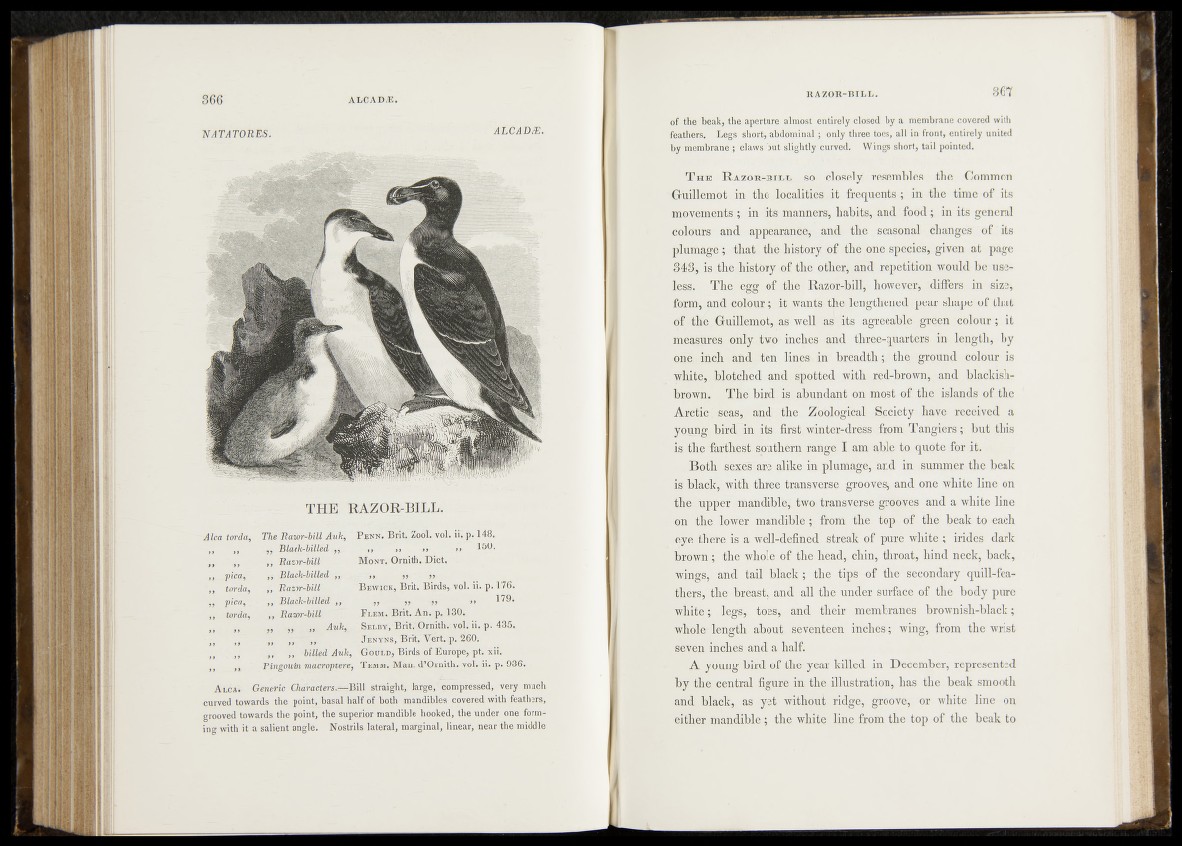
'NATATORES. ALCADÆ.
T H E RAZOR-BILL.
Alca tarda, The Razor-bill Auk, " P en n . B rit, Zooï. vol. ii£ p . 148.
Blfick-bitled 1 ■ I H Ï5Ô.
, , Razor-bill M ont. O rn itti^P ife t,
.pic®, ,-j. Black-billed. ^
tarda, „ Razpr^biîjL^, B ewick, B rit. B ird s, vol. ii. p . 1 ’76.
pica, v • ,, Blaçkrbiltêdl Jf 1 » » » 1 7 9 *
tarda, Sb Razor-bill FLEM. B rit. A n . p. 130«
^ Aiilc,A. ' SELÊY,'Brit,*;prnitli.'.vol. ii, p . 435*
J en yns / B rfÇ V e it. ,a&0.
,, billed Auk, G ould, B ird s o f Eu ro p e, p t. x ii.
, , Pingouin macroptere, T emm. M an . d ’O rn ith . y ol. ii. p . 9 3 6 .
Alca. Generic C h a r a c t e r s . straight, large,' compressed, very much
urved towards the point, basal half of both .mandibles covered with feathers,
rooved towards the point, the superior mandible hooked, the under one fortn-
lg with it a salient angle. Nostrils lateral, marginal, linear, near the middle
of the beak, the, aperture almost entirely closed by a membrane covered with
feathers. Legs short, abdominal; only three toes, all in front, entirely united
by membrane; ‘claws buit slightly curved. Wings short, tail pointed.
T h e R azor- b il l so closely resembles the Common
Guillemot in the localities it frequents; in the time of its
movements ;.in its: manners, habits, and food; in its general
colours and appearance* and the seasonal changes of its
, plumage; that the,history of the one species, given at page
343,^sithe .history -of the other, and repetition would be use-
-The egg of, the Razor-bill, however differs in size,
form, and .colour ; it wants the lengthened pear shape of that
of the Guillemot, as well as its agreeable green colour; it
measures only,; |wo inches abd three-quarters in length, by
om^.inch and.ten lines- in breadth; 'the ground colour is
white, .blotched and spotted y^ith red-brown, and blackish-
brown>. The bird, is abundant on most of the islands of the
Arctic.; seas, and -the Zoological Society have received a
young, bird In its first, winter-dress from T a n g ie rs b u t this
#|sf the farthest southern range I am %ble tp quote for it.
Both sexes' are alike in plumage, and in summer the beak
is black, with three transverse grooves, and one white line on
the upper mandible* two transverse grooves and a white line
on the lower mandible;. from the top of the beak to each
§f|re there is a well-defined streak of pure white ; irides dark
brown; the whole of the head, chin, throat, hind neck, back,
wings, and tail black; the tips of the secondary quill-fea-
fleers, the breast, and all the under surface of the body pure
white; .-legs, toes, and their membranes brownish-black;
whole- length about, seventeen inches; wing, from the wrist
seven inches and a half.
A young bird of the year killed in December, represented
by the central figure in the illustration, has the beak smooth
and black, as yet without ridge, groove, or white line on
either mandible; the white line from the top of the beak to